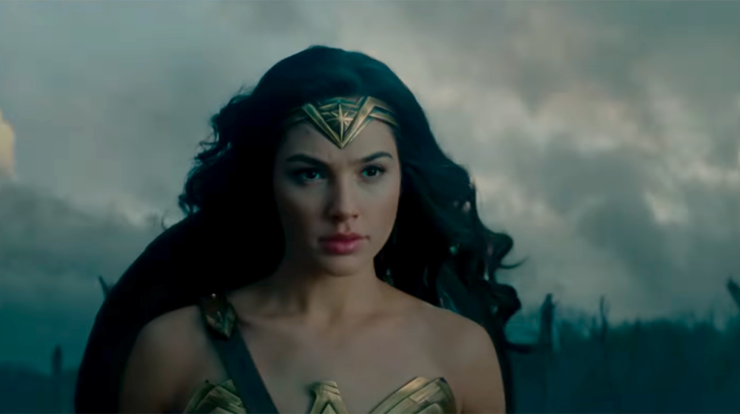Both Wonder Woman and Captain America were created in the days just prior to the United States’ entry into World War II. Both had costumes that evoked the red-white-and-blue of the American flag, and both spent their earliest days in comic book form fighting the Axis powers.
While Wonder Woman wasn’t specifically created to punch Nazis the way Cap was, the character continued to be associated with her WWII-era origins, in part due to the 1977 TV series initially taking place then. So when it came time to do a movie for her as part of DC’s Extended Universe, the powers-that-be decided to shift her back to the first World War to avoid comparisons to Captain America: The First Avenger.
William Moulton Marston, under the pseudonym Charles Moulton, created Wonder Woman in 1941 with Harry G. Peter. Marston famously lived a polyamorous lifestyle, sharing his life with both his wife Elizabeth Marston and their partner Olive Byrne. Both of the women in Marston’s life were inspirations for the character, who was created as a feminist icon before that phrase was really a thing, inspired by Marston’s own work as a psychologist, as well as the writings of many women’s rights advocates of the time, notably Margaret Sanger.
Wonder Woman has remained DC’s most prominent female superhero, often discussed in the same breath as Batman and Superman as DC’s “holy trinity.” Like most of DC’s characters, she was rebooted in 1986 following Crisis on Infinite Earths, with George Pérez, aided by Greg Potter and Len Wein, tying her more closely to her Greek mythological roots, and she was rebooted again in 2011 as the daughter of Zeus and Hippolyta, making her an actual demigod instead of a being created from clay and infused with life by the gods. The character has received other revamps over the years, ranging from her separating herself from Paradise Island and losing her powers, becoming a martial artist, in the late 1960s and early 1970s, to fellow Amazon Artemis taking over as Wonder Woman for a time in the 1990s.
Buy the Book


Null Set
Dozens of attempts over the years have been made to bring Wonder Woman to the screen in live-action, with only one truly successful: the 1977 TV series starring Lynda Carter. Prior attempts by William Dozier (which never got past its awful promo) and John D.F. Black (a mediocre pilot movie starring Cathy Lee Crosby) both failed, and subsequent attempts ranged from another failed pilot starring Adrianne Palicki in 2011 to multiple attempts to do a live-action movie with such names as Todd Alcott, Jon Cohen, Paul Feig, Leonard Goldberg, Matthew Jennison, Becky Johnston, Laeta Kalogridis, Philip Levens, Ivan Reitman, Brent Strickland, and Joss Whedon all attached to write and/or direct. Among the actor names attached over the course of the two decades leading up to the DCEU’s debut in 2013 were Sandra Bullock, Mariah Carey, Angelina Jolie, Lucy Lawless, and Catherine Zeta-Jones.
Warner Bros. eventually decided that a female director would make the most sense, initially hiring Michelle McLaren, who eventually quit over creative differences, replaced by Patty Jenkins.
Gal Gadot was already set in the role of Diana after being cast by Zack Snyder in Batman v. Superman: Dawn of Justice. That movie also set up her World War I roots with a picture of her with several people from 1918. The people in the picture—Chris Pine as Steve Trevor, Said Tagamaoui as Sameer, Ewen Bremner as Charlie, and Eugene Brave Rock as Chief Napi—all appear for real for the first time in this film. The cast also includes Lucy Davis as Etta Candy, David Thewlis as Sir Patrick Morgan (later revealed to be the Greek god of war, Ares), Danny Huston (last seen in this rewatch as the younger William Stryker in X-Men Origins: Wolverine) as General Ludendorff, and Elena Anaya as Isabel Maru (a.k.a. “Doctor Poison”). Playing Diana’s fellow Amazons are Connie Nielsen as Hippolyta (Diana’s mother), Robin Wright as Antiope, Lisa Loven Kongsli as Menalippe, Mayling Ng as Orana, Florence Kasumba as Acantha, Madeleine Vall Beijner as Egeria, Hayley Jane Warnes as Aella, and Ann Wolfe as Artemis.
Gadot, Nielsen, Wright, and Thewlis, will all next appear in Justice League. A sequel to this film, currently titled Wonder Woman 1984, was green-lit almost immediately after this one’s release, as it achieved a perfect storm of making a lot of money and having good word of mouth (the DCEU had only managed the first part up until this). WW84 is scheduled for a 2020 release, with Jenkins returning to direct, and Gadot obviously starring. Nielsen, Pine, and Wright are currently listed as starring in the film, along with Kristen Wiig as longtime WW adversary Cheetah. A third film is also planned, which Jenkins has said will take place in the present day.
“I can save today; you can save the world”
Wonder Woman
Written by Zack Snyder & Allan Heniberg and Jason Fuchs
Directed by Patty Jenkins
Produced by Charles Roven and Deborah Snyder & Zack Snyder and Richard Suckle
Original release date: June 2, 2017
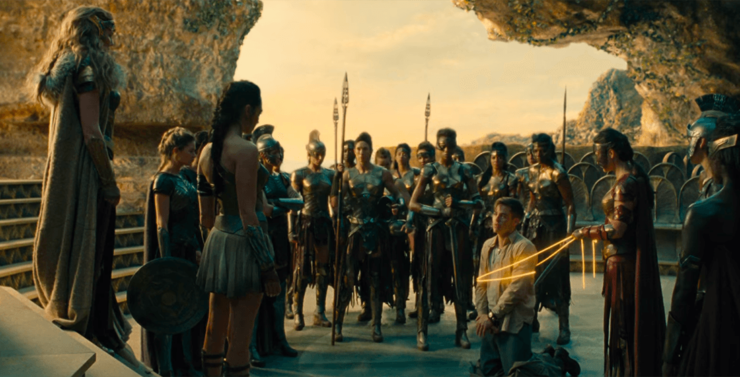
We open in modern Paris. A Wayne Enterprises courier delivers a package to Diana Prince in her office: the original of the 1918 picture of Diana with four men in France that we saw a digital scan of in Batman v. Superman: Dawn of Justice. This prompts Diana to have an extended flashback…
On the island of Themyscira, hidden from the rest of the world, the Amazons live in peace and harmony—but also constantly training in combat. There’s only one child on the island, Diana, whom we learn was molded from clay by Hippolyta and given life by Zeus. It was one of Zeus’s final acts when Ares killed him, and the Amazons were given Themyscira to await Ares’s return and defend the world against him.
Diana wishes to learn how to fight, but Hippolyta refuses. However, Hippolyta’s sister Antiope trains Diana in secret, because the truth (which Hippolyta keeps from Diana) is that she was created to be a warrior who can defeat Ares.
Eventually Hippolyta gives in and instructs Antiope to train Diana harder than any of the other Amazons until she is their greatest warrior.
She grows up to be a mighty warrior indeed, and in 1918, she spars with her sisters, at one point crossing her arms in defense against Antiope—an action that sends her aunt sprawling. (It’s similar to something she did against Doomsday in Dawn of Justice.) Frightened at this heretofore unknown ability and horrified that she’s hurt her beloved aunt, she runs away to a cliff, looking out at the ocean.
While she’s watching, a plane comes through the force field that keeps the island shielded from the outside world (and also seems to keep the island in perpetual sunlight, as it’s dark and foggy outside the field), which is followed by boats. The pilot of the plane is trapped in his now-sinking vessel, and Diana dives underwater to rescue him. The people in the boat—whom the audience recognizes as German soldiers serving the Kaiser, though the guy Diana rescued is also wearing that uniform—start shooting at them.
Hippolyta, Antiope, and the Amazons attack the invaders, and the battle is joined. Diana is appalled by the presence of rifles, especially after seeing what they do to a human body.
However, the Amazons are triumphant, aided by the pilot, though not without cost—among the dead is Antiope. The pilot is taken prisoner, and bound with the lasso of Hestia, which compels him to give his name, Captain Steve Trevor, and his purpose, which is a spy. (He’s very reluctant to admit that, for obvious reasons, as the worst thing a spy can do is admit to being a spy, but eventually the lasso compels him.)
He explains his mission. The Germans are on their last legs, but General Ludendorff and a scientist he has employed named Isabel Maru (nicknamed “Dr. Poison”) are working on an ultimate weapon. Trevor was tasked by British Intelligence with going to Germany undercover as a German soldier and reporting on Maru’s work. Seeing an opportunity, he steals Maru’s notebook, then steals a plane, using it to do serious damage to Ludendorff’s headquarters.
His plane is then shot down over the ocean, where Diana rescued him. The Amazons in general and Diana in particular ask what war he’s talking about, and Trevor is gobsmacked. “The war,” he says, not knowing how anyone could not know about it, eventually adding, “the war to end all wars.” His enumerating the death count of the war, which has gone on for several years now, devastates Diana, and while Trevor is recovering from his wounds, Diana offers to take him home if he’ll take her with him. Diana sneaks into the armory (involving jumping over a big chasm and climbing up the wall using strength she only just now realizes she has) and takes the lasso, the sword (which her mother told her can kill a god), and a shield.
She and Trevor sneak out to a boat, but Hippolyta and several Amazons meet her there. Hippolyta tries to convince her to stay (“If you choose to leave, you may never return”) but Diana is determined (“Who will I be if I stay?”). Hippolyta gives her Antiope’s headband to wear.
They sail out to sea, with plenty of conversation that is about as awkward as you would expect from a 1918 man and a woman who has lived her life as among a bunch of scholarly warrior women (she proves herself well read as well as badass), and Trevor thumphers a lot.
They catch a ride with a boat that tugs them into London. (“It’s hideous!” is Diana’s first impression, to which Trevor says, “Yeah, it’s not for everybody.”) Trevor introduces Diana to his secretary, Etta Candy, who takes Diana clothes shopping so she’ll blend in better than she will in Amazon fighting togs.
Afterward, they’re ambushed by German agents who want the notebook, but Diana takes care of them in fairly short order, aided slightly by Trevor himself. (He initially tells her to stand back until she deflects a bullet with her gauntlets, at which point he withdraws that suggestion.)
Trevor goes to meet with his superiors—the War Council led by Sir Patrick Morgan—who are discussing the waning days of the war, and who are appalled when a woman walks into the room. They’re also more than a little surprised when Diana translates Maru’s coded notebook, revealing that Maru has developed a gas that will be unleashed on the Western front before an armistice can be signed.
The council refuses to do anything, and orders Trevor to stand down. Diana is livid, both at the council and at Trevor for acquiescing, until he wraps the lasso around his own wrist to make it clear that he was lying to the council and he intends to go anyhow.
Diana is convinced that Ares is responsible for this war, and based on what Trevor has told her and what she’s read in Maru’s journal, she believes that Ludendorff is really Ares in disguise.
Trevor and Diana gather some ne’er-do-well comrades of Trevor’s, including Sameer, a con artist who works as a freelance spy; Charlie, a sharpshooter and drunk; and Chief Napi, a Blackfoot who chooses no sides in the war, but can get supplies and material for anyone who can pay for it. While they’re impressed by Diana—who takes out a brute who wants to beat up Charlie—they’re less impressed by the fact that Trevor can’t pay them. But then Sir Patrick shows up and gives Trevor funds to pay them all, sanctioning their mission as long as it remains covert, with Candy coordinating with him from London.
They head to France, and work their way through there to the Belgian front. Diana gets to see the carnage, the broken and wounded and dead bodies, and is appalled. She’s even more appalled when she talks to Napi and learns that it is Trevor’s people—the Americans—who all but wiped out his own people.
When they arrive at the front, she learns that, on the other side of “no man’s land” (Trevor says that “no man” can cross it, and it’s to the scriptwriter’s credit that she doesn’t respond with an obvious rejoinder about how she’s no man), there’s a village called Veld that the Germans have enslaved.
Against Trevor’s wishes, and to everyone’s shock, Diana goes over the top and walks across no man’s land, drawing the Germans’ fire, which enables Trevor and his gang, as well as the British and French and American troops to charge across and take the German trench. Even as the soldiers secure the trench, Diana, Trevor, Charlie, Sameer, and Napi—but, y’know, mostly Diana—liberate Veld. (At one point, Trevor and the gang re-create a move he saw Antiope pull off on Themyscira involving Diana using a shield as a jumping-off point to take a mighty leap.)
The town is liberated, and the people celebrate. A photographer poses everyone for a picture. (Thus bringing everything full circle.) Diana and Trevor wind up sleeping together. They contact Candy, who informs them that there’s a gala for the German hoi polloi being held at a nearby castle, from which Ludendorff will launch his latest weapon from Maru. For their part, Ludendorff and Maru have already tested that weapon on a gathering of German top brass.
Trevor and Sameer infiltrate the party as a German soldier and his driver, but Diana on her own does likewise, stealing a dress from an aristocratic German woman. Trevor stops her from killing Ludendorff in the middle of the party, which would get them all killed. Ludendorff then launches Maru’s gas toward Veld, killing everyone.
Diana blames Trevor for staying her hand, and she abandons him. Napi tracks Ludendorff to an airfield where Maru has a lab. Diana goes there, and confronts Ludendorff, to whom Maru has given a gas that gives him super-strength. This means he’s able to put up a fight against Diana for more than six-and-a-half seconds, but she still is able to kill him—
—at which point, to her abject shock, the war doesn’t end. Trevor tries to explain that the war isn’t because of a god’s manipulation, but she doesn’t want to hear it.
And then Sir Patrick turns up, and reveals that he’s Ares. He didn’t start the war, he’s merely pushed at tensions and brutality that were already present. He wants humanity to wipe itself out so the Earth can be a paradise again like it was in the heyday of Mount Olympus. She tries to kill him with the sword, which Ares destroys. Ares reveals to Diana that she’s the god-killer, not the sword.
Trevor and the gang destroy Maru’s lab. Trevor says his goodbyes and I-love-yous to Diana and then hijacks the plane that will attack London with Maru’s new gas. Once it’s high in the sky, Trevor blows it up, sacrificing his life.
Ares offers Maru’s life to Diana by way of tempting her over to the dark side, but she refuses, preferring love over war. She spares Maru and then absorbs Ares’s direct attack upon her and throws his power right back into his face.
London is saved, the war ends, and Diana, Sameer, Charlie, and Napi have a muted celebration, given that Trevor is gone.
In the present, Diana e-mails Bruce Wayne a thank-you for the picture, and she reaffirms her commitment to fighting for justice.
“I cannot stand by while innocent lives are lost!”
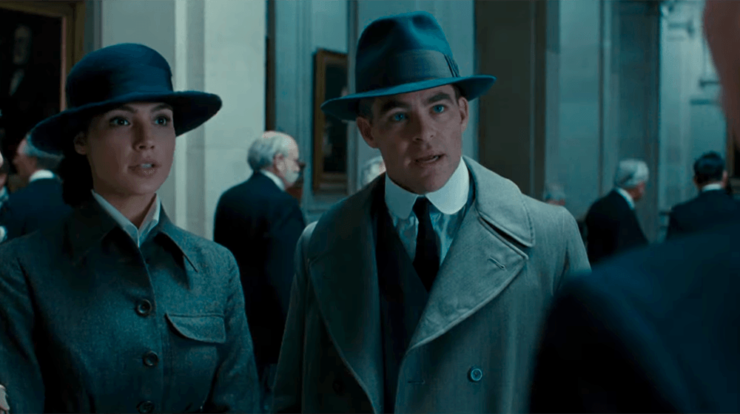
It’s easy, and a bit facile, to say that this is the best movie in the DC Extended Universe, as it’s damning with the faintest of praise. The best of its competition is mindless goofiness.
It’s just as easy, and just as facile, to call this the best female-led movie in this rewatch so far, given that the only serious competition it had upon its release is another movie adapting the same character: The New Original Wonder Woman four decades prior to this, and that was a pilot for a TV show. The feature film landscape of live-action superhero comic book adaptations has not been kind to women.
In truth, women have had far more success in this subgenre as leads on the small screen, most recently seen in Supergirl, Agent Carter, and Jessica Jones.
With this movie, we finally get a good live-action female-led superhero comic-book movie and a good DCEU movie, and it’s about fucking time. In particular, for the first time in this particular cinematic cycle, we have a movie that remembers that the world has color in it. While Zack Snyder’s fetish for browns, blacks, and grays in his cinematographical choices are easy to blame, it should be pointed out that Suicide Squad was almost entirely in grayscale as well, with most of the action taking place at night, in the rain, or in a city that was covered in a literal cloud of evil. Here, at last, we have colors, and it’s amazing! From the tropical sunlight on Themyscira to the red-white-and-blue of Diana’s outfit—which we don’t really get a good look at until that crowning moment of awesome when she goes over the top—it’s a bright, beautiful movie.
Gal Gadot continues her superlative work. After being one of the few bright spots of Dawn of Justice, here she gives us a Wonder Woman who is strong, passionate, compassionate, a bit naïve (though the movie is about her getting past that), brilliant, and happy. She is a person who takes absolute joy in life, and is fervent in all her passions, whether it’s something as minor as seeing a baby or as unexpected as being able to break stone and metal with her bare hands or as major as walking across “no-man’s land” to save a town.
It’s a testament to how strong the Themyscira segments are that I had forgotten what a tiny percentage of the movie’s screentime they actually have. Connie Nielsen and Robin Wright only have a fraction of the film’s running time, but they absolutely make the most of it. Nielsen’s Hippolyta is obviously torn between protecting the island’s only child with her duties as queen, and Antiope is a most worthy mentor to a great hero, a powerful and wise warrior played with overwhelming gravitas by Wright.
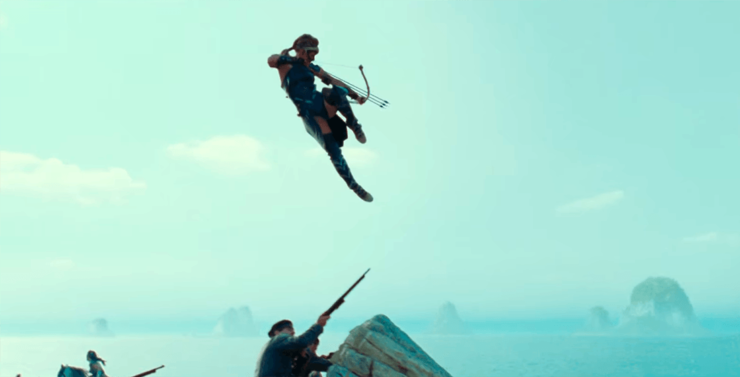
Chris Pine is also superlative as Diana’s sidekick. I like the reworking of him as a spy rather than simply an Army pilot, as his covert work makes him well suited to deal with the many curveballs that crashing in Themyscira throws at him. Pine has a particular ability to completely inhabit whatever role he’s playing, whether it’s Steve Trevor, Captain Jim Kirk, Jack Ryan, a drunken reporter, or a neo-Nazi speed freak.
I particularly like that Trevor and Chief Napi are the only people from America in this movie, and that the United States is mostly irrelevant to the story. It takes place in the Atlantic Ocean and Europe, the characters that aren’t from the mystical island that traces its roots to ancient Greece are mostly European, and both Trevor and Napi are working for British Intelligence specifically. It emphasizes Diana’s importance to the entire world, not just the U.S., to which she has always been unconvincingly tethered.
The script does a very nice job of balancing early-20th-century sexism with Themyscira’s more enlightened philosophy, and does so without overly caricaturing that sexism, but not pretending it doesn’t exist, either. Sameer’s attraction to Diana could be a leering stereotype and it’s to the credit of the scripting, the directing, and Said Tagamaoui’s acting that he instead simply comes across as tiresomely quaint. The support for the good guys is generally excellent, from Tagamaoui’s charm to Ewen Bremner’s drunken loopiness as Charlie to Eugene Brave Rock’s dignified turn as Napi to Lucy Davis’s hilarious and nicely layered portrayal of Etta Candy.
Sadly, the acting kudos can’t really extend to the bad guys. David Thewlis is perfect as the British aristocrat, but when called upon to be the god of war, buried in CGI garbage, he’s considerably less effective. It’s hard enough for anyone to play Ares without comparing them to the late Kevin Smith’s superlative work in that role in Xena and Hercules twenty years ago, and Thewlis just can’t convey the required menace once he’s dressed in CGI armor and shooting ray beams from his fingertips. And Danny Huston is just as boring here as he was in X-Men Origins: Wolverine, and at least there he had the excuse of being in that movie; he has no such out here, he’s just dull as hell. I’d much rather have seen more of Elena Anaya’s Dr. Maru, as she showed much more potential. The scene where Trevor, posing as a German general, tries to recruit Maru was brilliantly played by Pine and Anaya both, and the sight of her without her ceramic mask, revealing the scars from her own gas experiments, all hinted at a much more interesting conflict than the one with Huston’s bland Ludendorff.
The story borrows a little too much from other sources. For all that the comics character’s origin was yanked back two decades to avoid being too similar to that of Captain America, the story takes a lot of beats from The First Avenger, from the Howling Commandos equivalents in Trevor’s gang of ne’er-do-wells, to the bad guy murdering several high-ranking German officials with an unconvincing lack of consequences, to the male lead destroying a plane and sacrificing himself to keep that plane from causing wanton destruction to the good guys.
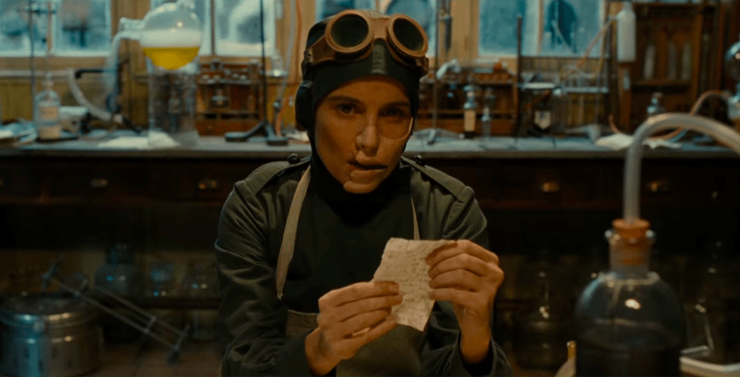
However, the most frustrating theft is that of George Pérez’s initial story arc in his 1987 reboot of Wonder Woman, because it blows the ending. Pérez emphasized the diplomatic aspects of Diana coming to “man’s world,” having her be an envoy from Themyscira, not just a warrior there to fight. The script to this movie pays lip service to that, with Diana saying that love can save the world, but the actual actions of the movie belie that, as Diana saves the day, not with love, but with her ability to throw Ares’s ray beams back at him full force. Snore.
And what’s maddening is that the ending of that Pérez arc was a masterstroke. Wonder Woman doesn’t stop Ares—who has manipulated the U.S. and the Soviet Union into barreling toward nuclear war—by overpowering him, but instead by wrapping him in the lasso of truth and showing him what a nuclear war would actually mean.
This movie can’t do that exact story, as the devastation of World War I was not quite the same as a nuclear war would be, but it’s still pretty horrible, and having Diana win by showing Ares the truth, that wiping out humanity will just make him a god of nothing, would have been very effective, and spared us Yet Another CGI-Drenched Climax to a superhero film.
Having said that, the movie is still fantastic. Gadot beautifully plays a hero who starts from a place of compassion. When her parent cautions her against using her powers in the world, Diana gives the life-affirming, heroic response that Clark Kent should’ve given to his sociopath father in Man of Steel. The moment where she says, “Who will I be if I stay?” was one where I cheered (quietly) in the theatre, and did so again (more loudly in my living room) when rewatching it for this entry.
That is how you write a superhero. And she still has a journey to go on, as she’s so incredibly convinced that stopping Ares will stop the war. She can’t believe that people would be this horrible to each other, and it’s a bucket of ice water in the face when she realizes that Ares was just fanning a flame that was already there.
Wonder Woman is a bright jewel in a tarnished crown, and luckily works just fine on its own without the cruft of the rest of the DCEU, instead telling a story of the tragedies of war, and how one brave person can stem the tide against the darkness.
Next week, Bruce Wayne gets the band together for Justice League.
Keith R.A. DeCandido, whose birthday was yesterday, has compiled collections of quotes by and about both Batman and Wonder Woman for the Insight Editions Tiny Book series. The Batman book is entitled Batman: Quotes from Gotham City, and will be out in July—the WW book hasn’t been scheduled or titled yet. Also coming in July is Keith’s Alien novel Isolation, based in part on the 2014 videogame of the same name, as well as stories in the anthologies Thrilling Adventure Yarns and Brave New Girls: Adventures of Gals & Gizmos, the latter of which benefits the Society of Women Engineers.










